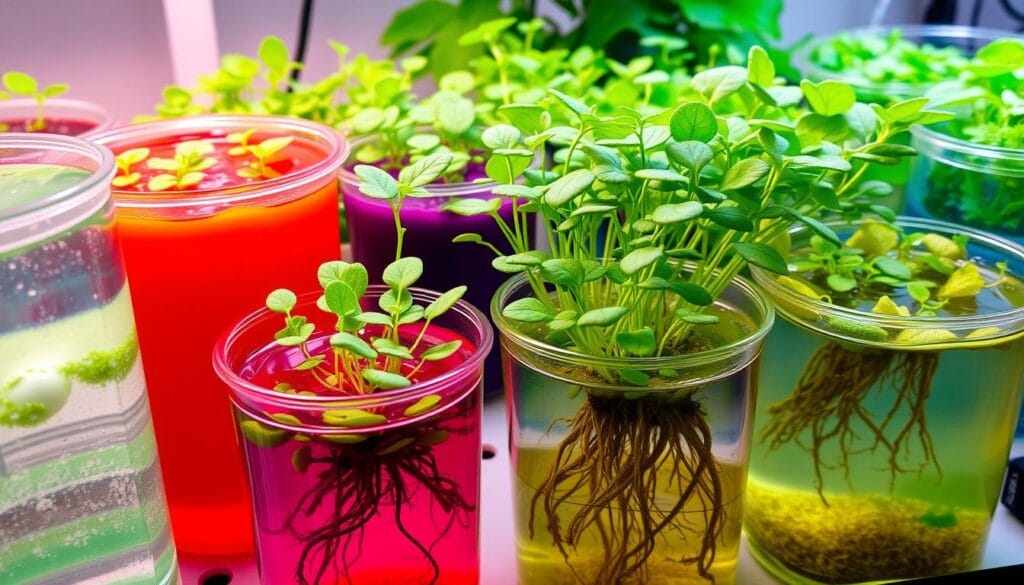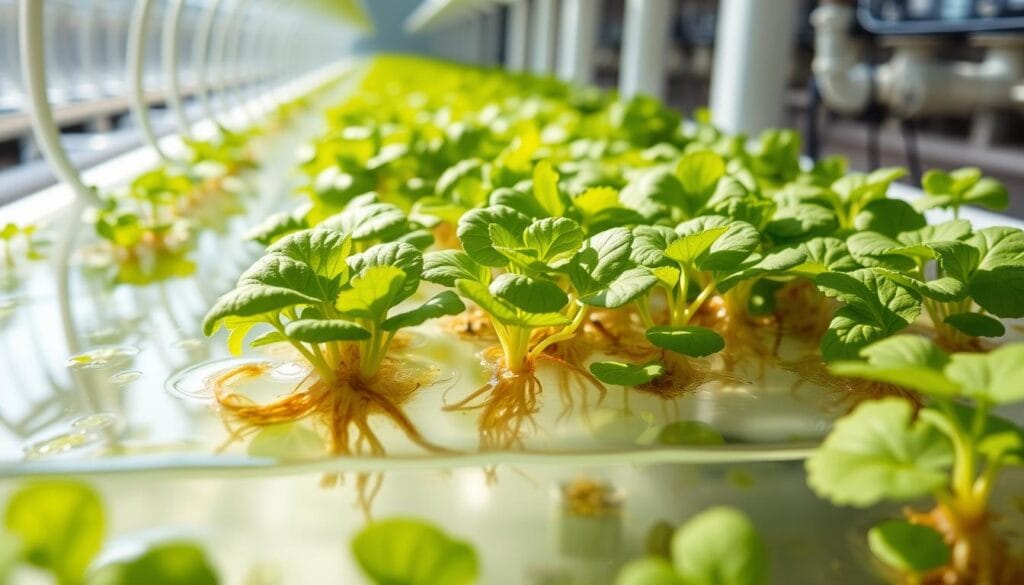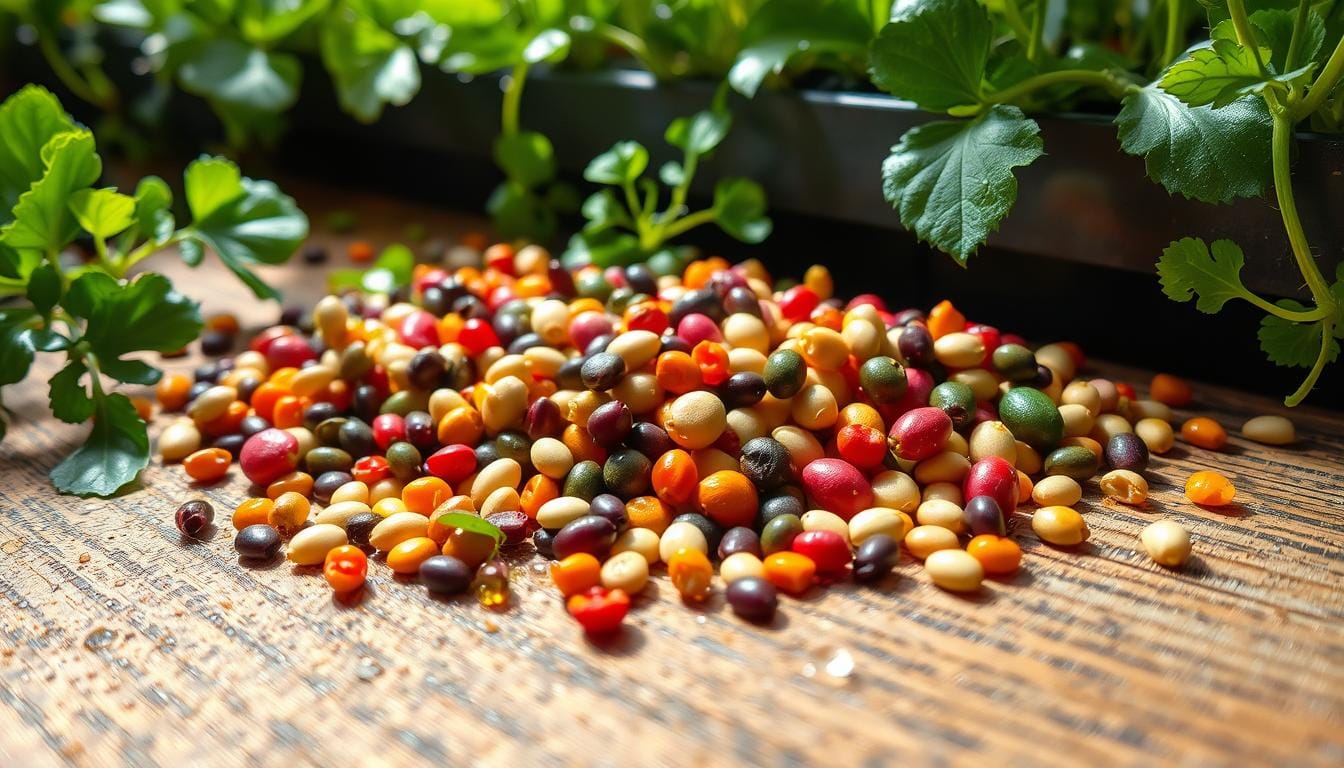Can You Use Any Seeds in Hydroponics? Starting your hydroponic garden is exciting and a bit overwhelming. You might wonder, ‘Can I use any seeds in my hydroponic system?’ The response can’t be reduced to a simple yes or no. Hydroponics lets you grow many types of plants, but not all seeds work well in this method.
This guide will help you understand hydroponic seed selection. We’ll clear up myths and give you the key tips for success. Whether you’re new to hydroponics or have experience, these tips will help you make the best choices for your garden.
Key Takeaways
- Hydroponics allows for year-round fresh produce, even in urban settings, but not all seeds are suitable for this soilless cultivation method.
- Proper lighting, temperature, and humidity control are crucial for the success of hydroponic seedlings.
- Certain plant varieties, such as leafy greens, herbs, and quick-growing crops, thrive particularly well in hydroponic systems.
- Maintaining a delicate balance of essential nutrients is key for healthy seed development and seedling growth in a hydroponic environment.
- Hydroponic gardening provides a pest-free, low-maintenance alternative to traditional soil-based gardening, but it requires careful monitoring and adjustments.
Understanding the Basics of Hydroponic Seed Selection
Seed selection is key in hydroponic gardening. The right hydroponic seed varieties can greatly impact your plant’s growth and yield. It’s vital to know the unique needs of hydroponic systems, which differ from traditional soil gardening.
What Makes Seeds Suitable for Hydroponics
Seeds suitable for hydroponics must be disease-resistant and adaptable to soilless environments. Look for seeds bred or selected for hydroponics. These seeds tend to be more vigorous, with better germination rates and performance without soil.
Common Misconceptions About Hydroponic Seeds
- Not all seeds will perform equally well in a hydroponic setup. Some seeds may struggle to thrive in the water-based environment.
- Seed propagation methods used in soil-based gardening may not necessarily translate well to hydroponics. Seed propagation methods may need to be adjusted to suit the specific requirements of a hydroponic system.
- Thinking that any seed can be used in hydroponics. It’s essential to research and select seeds that are known to perform well in soilless cultivation.
The Role of Seed Quality in Hydroponic Success
High-quality seeds are crucial for robust growth and high yields in hydroponics. Investing in premium, disease-resistant seeds can lead to consistent germination and healthy plants. Before starting your hydroponic garden, research the best hydroponic seed varieties for your crops and conditions.
“Choosing the appropriate seeds for your hydroponic system can significantly impact the health and yield of your plants.”
Seeds for Hydroponics: Essential Guidelines for Beginners
Starting with the right seeds is key for success in hydroponic gardening. There are a few important guidelines to help you begin well.
Begin with easy plants like lettuce, spinach, and herbs. These plants thrive in hydroponics and are perfect for beginners starting out. When picking your hydroponic seed suppliers, choose companies known for hydroponic-friendly varieties.
- Consider pre-germinated seeds or seedlings for a quicker start, as they’ve already begun the germination process.
- Avoid overcrowding your hydroponic system by planting the appropriate amount of seeds. According to the article, it’s recommended to initially drop two to three seeds in each starter plug to ensure successful germination, as not all seeds may sprout.
- Regular seedling care and monitoring are essential for successful hydroponic gardening. The guide suggests that seeds should sprout within three to five days for most plants, indicating a relatively quick germination process compared to traditional soil methods.
Remember, a well-planned and carefully maintained hydroponic system can provide a bountiful harvest with minimal effort. By following these essential guidelines, you’ll be on your way to growing a thriving indoor garden in no time.
Best Plant Varieties for Hydroponic Growing
Hydroponic gardening has changed how we grow veggies, herbs, and fruits. It lets us grow plants in water and nutrients, not soil. This method is efficient and versatile for growing plants without soil.
Choosing the right plants for your hydroponic garden is easy. There are many options to pick from.
Leafy Greens and Herbs
Leafy greens like lettuce, spinach, and kale do well in hydroponics. They grow fast and healthy in the nutrient-rich water. Herbs such as basil, parsley, and cilantro also grow well here. They add flavor to your meals.
Fruiting Plants
You can also grow fruiting plants like tomatoes, peppers, and strawberries in hydroponics. These plants need special support and nutrients. But, they can produce amazing results.
Quick-Growing Crops
For fast results, hydroponics is great for quick-growing crops like radishes and microgreens. They can be ready in 1-3 weeks. This makes them perfect for new gardeners.
Hydroponic gardening lets you try many different plants and growing methods. With the right care, you can grow a lot of fresh, healthy food at home.
| Plant Variety | Days to Maturity | Mature Size | Light Requirements | Recommended Hydroponic System |
|---|---|---|---|---|
| Lettuce | 25-60 days | 6-12 inches tall | Full to partial sun | Water culture system |
| Spinach | 28-55 days | 6-12 inches tall | Full to partial sun | Water culture system |
| Basil | 40-60 days | 12-24 inches tall | Full sun | Ebb and flow system |
| Tomatoes | 50-80 days | Varies by variety | Full sun | Nutrient film technique (NFT) system |
Hydroponic gardening lets you grow many different plants. From leafy greens and herbs to fruiting plants and quick-growing crops. By knowing what each plant needs, you can create a garden that gives you lots of fresh, tasty food.
Proper Nutrient Requirements for Seed Development
In hydroponic gardening, giving the right nutrients is key for seed growth. Plants need a special nutrient mix for each growth stage. Important nutrients like nitrogen, phosphorus, and potassium help seeds grow well. Also, micronutrients like iron, manganese, and zinc are vital for plant health.
Keeping the pH levels right, between 5.8 and 6.4, helps plants absorb nutrients better. As plants grow from seedlings to adults, changing the nutrient mix is crucial. This ensures they get the right nutrients at each life stage, promoting strong growth.
| Nutrient | Function | Optimal Range |
|---|---|---|
| Nitrogen (N) | Promotes vegetative growth, leaf and stem development | 100-200 ppm |
| Phosphorus (P) | Supports root growth, flower and fruit formation | 40-80 ppm |
| Potassium (K) | Improves overall plant health, drought resistance, and fruit quality | 100-200 ppm |
| Iron (Fe) | Crucial for chlorophyll production and photosynthesis | 2-4 ppm |
| Manganese (Mn) | Necessary for enzyme activation and chlorophyll formation | 0.5-1 ppm |
| Zinc (Zn) | Involved in growth regulation and protein synthesis | 0.1-0.5 ppm |
By watching and adjusting the hydroponic nutrients in your system, you help your plants get the best nutrients. This supports strong seed development and overall health.

Germination Techniques in Hydroponic Systems
Thriving hydroponic gardens start with seed germination mastery. Knowing how to care for hydroponic seedlings is key. This ensures a strong start and future harvests.
Temperature and Humidity Control
Right temperature and humidity are vital for hydroponic germination. Keep your growing area at 65°F to 75°F for seed sprouting. Also, keep humidity between 50-70% for the best moisture balance.
Light Requirements for Seedlings
Good lighting is crucial for seedling growth in hydroponics. Give your plants 14-16 hours of light daily. Use energy-efficient LED grow lights for the best results.
Timing Your Seed Starting
Start seeds regularly to keep your garden thriving. This ensures continuous harvests and fresh produce. Find the best seed-starting schedule for your garden.
Mastering hydroponic germination is key to a thriving garden. With the right temperature, humidity, lighting, and timing, your seedlings will thrive.
| Hydroponic Germination Essentials | Recommended Ranges |
|---|---|
| Temperature | 65°F to 75°F |
| Humidity | 50-70% |
| Light Exposure | 14-16 hours daily |
| Seed Soaking Time | 6-36 hours |
| Germination Rate | Aim for high rates |
“Taking the time to soak seeds can promote more consistent growth among seedlings, particularly when using microgreen growth mats.”
Common Challenges in Hydroponic Seed Starting
Starting a hydroponic garden is exciting and rewarding. Nevertheless, it presents its own challenges. You might face a few common issues when growing seeds in a hydroponic system. Let’s look at some common problems and how to solve them for healthy seedlings.
Overwatering and Nutrient Imbalances
One big worry in hydroponic seed starting is overwatering. Without soil, plants can easily get waterlogged. This can lead to root rot and various other issues. It’s important to check the water levels often and adjust your watering schedule.
Also, keeping the right balance of nutrients in your solution is key. Watch the nutrient levels closely and make changes as needed. This helps avoid nutrient deficiencies or toxicities.
Lighting Challenges
Good lighting is essential for seed germination and growth in hydroponics. Without sufficient light, seedlings may grow weak and develop a leggy appearance. Make sure your setup provides the right light intensity and duration for your plants, whether natural sunlight or artificial grow lights.
Pest and Disease Management
Even indoors, hydroponic systems can get pests and diseases. It’s crucial to watch for signs of these problems. If you find any, use organic or biological controls to fix it quickly.
Knowing these common challenges and how to solve them can help your hydroponic journey succeed. Every system is different, so you might need to try a few things to find what works best for you and your plants.
| Challenge | Potential Impact | Recommended Solutions |
|---|---|---|
| Overwatering | Root rot, plant decline | Regularly monitor water levels, adjust watering schedule |
| Nutrient Imbalances | Nutrient deficiencies or toxicities, stunted growth | Closely track nutrient levels, make timely adjustments |
| Inadequate Lighting | Leggy, weak seedlings, poor growth | Ensure proper light intensity and duration, use artificial grow lights if needed |
| Pests and Diseases | Infestations, plant damage, reduced yields | Regularly inspect for signs of issues, use organic or biological controls |
By tackling these common challenges, you can create a great environment for your hydroponic seedlings. This sets the stage for a successful and bountiful hydroponic garden.
Setting Up Your Hydroponic Garden for Seed Success
Starting a hydroponic garden needs careful planning and the right tools. To make sure your seed-based hydroponic system thrives, focus on these key points:
Essential Equipment Needed
For a successful hydroponic garden, you’ll need grow lights, pumps, and reservoirs. Pick energy-saving LED grow lights for your seedlings. Good water pumps keep the nutrient solution moving. Reservoirs hold the nutrient-rich solution.
Also, choose a growing medium like rockwool or coco coir. It supports the roots and keeps them aerated.
Environmental Controls
Keeping the environment right is vital for seed germination and plant growth. Use precise controls for temperature, humidity, and air flow. Aim for a room temperature of 68-73°F (20-23°C). Keep humidity between 42%-58% to avoid powdery mildew and root rot.
Monitoring Systems
Monitoring your hydroponic system closely is essential. Use testing tools to check pH, EC levels, and nutrient amounts. Think about getting automated systems for consistent care and to avoid nutrient imbalances.
By picking the right hydroponic equipment and using strong environmental controls, you’re on the path to a successful hydroponic garden. It will help your seed-grown plants grow well.
Maintaining Healthy Seedling Growth
When growing plants hydroponically, it’s important to care for your seedlings well. Keeping the right nutrient levels, pH balance, and environment is key. This ensures your hydroponic seedling care and hydroponic plant health stay great.
Regular pruning and trimming help your plants grow strong. Watch for nutrient issues and adjust as needed. As they grow, change the light to meet their needs.
Use pest control to keep your plants safe. Make sure plants have enough space to grow well. This prevents overcrowding and helps them thrive.
| Nutrient Requirement | EC Range | Duration |
|---|---|---|
| Seedlings (2-4 weeks) | 0.3 – 0.6 | 2-4 weeks |
| Mature Seedlings (4+ weeks) | 0.6 – 1.6 | 2-4 weeks |
| Flowering Plants | 1.6 – 2.4 | 6-12 weeks |
| Flushing (Maturation Phase) | 0.0 – 0.4 | 5-10 days |
Use a nutrient additive to boost chlorophyll and health. Regularly check the nutrient solution’s strength with EC/PPM meters. This helps manage plant nutrition well.

“Ensuring your hydroponic seedlings thrive requires maintaining the proper balance of nutrients, light, and environmental conditions.”
Conclusion
Hydroponic gardening brings many benefits, like faster growth and higher yields. You can grow fresh produce all year, no matter the weather. This method also saves water and uses land wisely, making it a great choice for farming.
Choosing the right seeds and taking good care of them is key. Knowing what each plant needs helps you grow many types of food. Always keep learning and adjusting to get better at hydroponics.
Hydroponic gardening is for everyone, whether you’re new or have experience. It lets you turn your home into a lush, self-sustaining garden. With the right skills, you can enjoy fresh, healthy food all year. Start your journey into sustainable gardening today and see the benefits for yourself.

